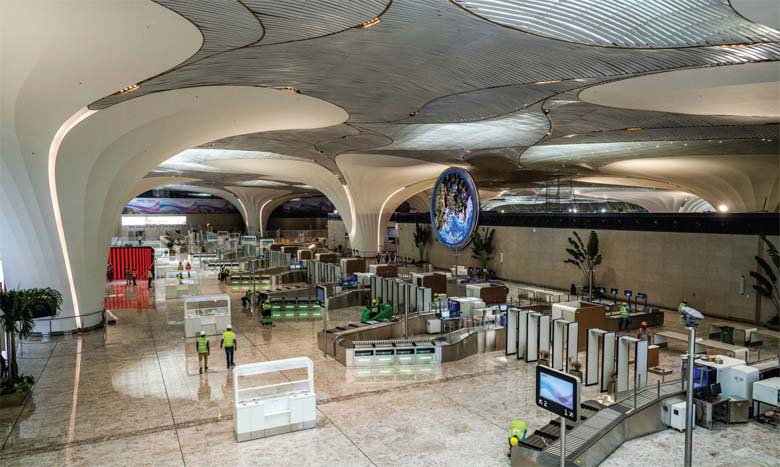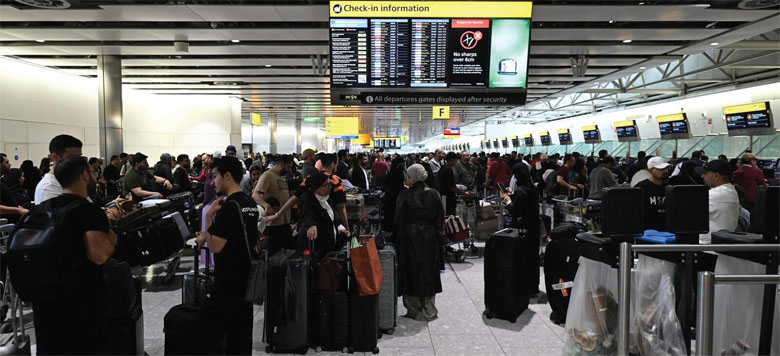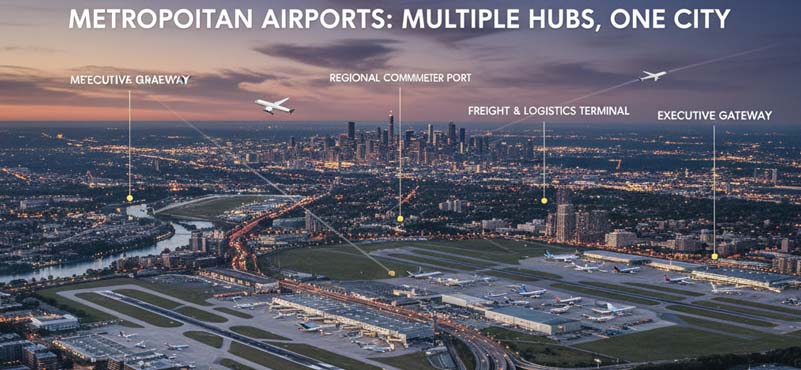As cities grow in population and wealth, the need for air connectivity also grows. Airports are limited with availability of land as well as air congestion making the problem of air traffic management more difficult. Then there are security issues. If a mishap takes place or weather turns bad in an area around the airport, is there an alternative airport. Even a union-based airport strike or a cyber-attack can put an entire airport at risk. Maintenance and re-carpeting an airstrip can be long and entails reduction of flights. Parallel airstrips at an airport are extremely helpful, but too many parallel airstrips can be a safety hazard and requires more land which May not be available at site. Mumbai airport had a peculiar problem. With over 100,000 jhuggis encroaching the land it could not even complete the parallel taxi track on its single airstrip leave aside building a parallel airstrip for the financial capital of India. Even after money had been deposited by the Airports Authority of India in advance many decades back as required with the Maharashtra government there to remove and rehabilitate the slum dwellers in order to expand the airport with a parallel airstrip, was no political will with the Maharashtra governments. Consequently, the airport could nor grow and reached a saturation point. With so many knowns and unknowns under Indian conditions it would be safer to have more than one airport for mega-cities.

What’s happening in other parts of the world?
As airports are becoming more and more susceptible to cyber attracts or drone citing and extreme weather due to climate change, it can put a whole airport dysfunctional. Cyber attracts have been frequent and recently it has been reported that Brussels and Berlin airports had disruption due to this. Heathrow of London has been impacted similarly. More popular are cyber-attacks on airline who maintain sensitive data bank of their passengers with details of their passports and credit cards etc. Stealing such details have a great market value and airlines do not want publicity on such an issue. Therefore, often they give in to a ransom demand for return of data. This has happened to Indian Airlines too. Hacking off airport computers can be more serious, especially if it pertains to Air navigation issues. If an airport air traffic control is attacked by cyber criminals, its motive could even be a political. Another nuisance is Drone sighting which involves closing of the airport temporarily like the recent airport closures in Denmark and Norway. Such random drone citing, generally by amateurs, is very upsetting for airports who have to close the entire airport till the issue is resolved. Airports would now need to set up their own anti-drone systems to detect and mitigate un-authorised drone activities. Over time global seat capacities have surged threefold in the last decade reaching six billion a year. The top mega-airports get a major part of the increase in traffic compared to other airports. Therefore, the trend is towards more than one airport serving a big city.
 For instance, the top ten airports like London’s Heathrow, Istanbul’s IST Airport, Kaula Lumpur’s International airport, Frankfurt International, Seoul’s Incheon, Chicago O’Hare International, Atlanta’s Hatsfield- Jackson International, Tokyo’s Haneda, Paris’s Charles de Gaulle all have along with them at least one or two other city airports serving their city. Generally, one is the main international airport and the others are smaller and usually cater to Low-cost airlines.
For instance, the top ten airports like London’s Heathrow, Istanbul’s IST Airport, Kaula Lumpur’s International airport, Frankfurt International, Seoul’s Incheon, Chicago O’Hare International, Atlanta’s Hatsfield- Jackson International, Tokyo’s Haneda, Paris’s Charles de Gaulle all have along with them at least one or two other city airports serving their city. Generally, one is the main international airport and the others are smaller and usually cater to Low-cost airlines.
However, Saudi Arabia has very recently announced a mega Airport at Riyadh which involves construction of a new airport and is termed as an Aerotropolis for both domestic and international travelers. It is a futuristic dream project. It involves the construction of a new international airport named King Salman International Airport and is set to become the largest in the world, dethroning King Fahd International Airport, which is also located in Saudi Arabia. It’s coming up as an Aerotropolis with six parallel runways stretching over the 57 sq.km. The project will include almost 12 square km of residential and recreational zones. The aim of the project is to accommodate up to 120 million passengers by 2030 and up to 185 million by 2050 with the objective to “transform Riyadh and make it one of the 10 most economically important cities in the world” with a population estimated at between 15 and 20 million people by 2030.
India’s Airport Policy
Indian policy regarding second airport for a city came out first in 1999 as a policy of exclusion a second airport for a city as an airport was a monopolistic business. The policy on airport infrastructure stated that no new airport should come up within a radius of 150 km of an existing one. It was felt that since Airport was a monopolistic body in the public sector and with only less than a dozen airports in profits out of over 80 then operating airports in the country, it would be a wasteful expenditure to allow a second airport as all airports were then running below their maximum capacity. It also protected finances of Airports Authority of India (AAI) which was obliged to maintain and invest in non-profit making airports around the country from their common non-lapsable fund. By 2008 a Policy for greenfield airports was announced which brought flexibility to this policy of 150 km and permitted a second airport within 150 km on a case-by-case basis. Finally, in 2016 a National Civil Aviation Policy was announced which modified the policy of banning another airport coming up with the radius of 150 km of an existing AAI Airport by providing suitably compensation AAI in case it’s existing airport does not get saturated by the year of commissioning. Compensation was offered in various forms and not in cash. This was done to protect the existing AAI investments as it was not getting any budgetary support and they had to maintain a large number of airports with full staff, safety and security apparatus. Further, even when a new airport came up in a city as in the case of Bengarulu or Hyderabad, the old one was made to shut down for commercial purposes.

Currently, two new greenfield airports are coming up in the vicinity of our two mega cities: Delhi and Mumbai perhaps within this year or early next year fully licensed by DGCA. Goa already has two airports within 150 km of each other but the difference is that one of them at Dabolin is a Naval Airport and therefore does not come in conflict with the policy.
This development is a welcome development as air traffic is growing in metro cities. Both in Delhi and Mumbai the existing airports are restricted by the land they have which cannot be expanded due to built-up area with multi stories buildings around it. These constructions do not allow sufficient space for the open funnel required for a parallel airstrip.
It is high time to consider second airports for a few other cities like Chennai, Kolkatta, Hyderabad and others. This is so because after looking into the potential growth of civil aviation in India they too will require a second airport. The crucial issue is to locate appropriate piece of land for the second airport with its technical requirements and not too far from the city. Generally, in India this is a difficult problem and therefore, sooner suitable lands are acquired by the State government/ AAI the better. As land around cities are getting built up locating suitable land for a second airport not too far from the city will either not be easily available and become very expensive. Already new airports are often 50 to 70 Km away from cities abroad due to non-availability of suitable land in other parts of the world and a fast link train and expressway then has to be provided to the city which is also an expensive proposition. AAI will do well to build up land bank for future second airports in our growing cities as early as possible and hold it for future development. Once a land parcel is purchased for an airport development, restrictions with regards to construction around it also come up, as provided under Airport Act, especially with regards to the funnel requirements.
ABOUT THE AUTHOR
 Sanat Kaul is Chairman of International Foundation for Aviation,Aerospace and Drones.
Sanat Kaul is Chairman of International Foundation for Aviation,Aerospace and Drones.








